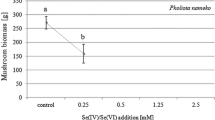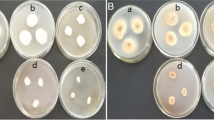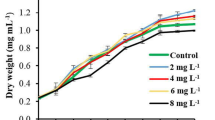Abstract
Selenium (Se) is an essential trace element for humans and animals. Stropharia rugoso-annulata is a nutritional and functional mushroom containing many kinds of bioactive ingredients. The aims of this study were to investigate the Se-enrichment characteristics of S. rugoso-annulata in submerged culture and evaluate the antioxidant activities of Se-enriched mycelia in vivo in terms of the values of glutathione peroxidase (GSH-Px), superoxide dismutase (SOD), and malondialdehyde (MDA). The optimum parameters of Se-enrichment under the optimal Se concentration (150 μg/mL) in media were as follows: biomass 8.11 ± 0.25 g/L, Se content in mycelia 4,727.68 ± 13 μg/g, Se-accumulated rate 24.68 ± 1.67%, and percentage of organic Se 96.27 ± 3.26%. The mainly subsistent forms of selenium in Se-enriched mycelia were selenoprotein and selenium-polysaccharide. The contents of total amino acids (TAA) and essential amino acids (EAA) in Se-enriched mycelia were increased by 13.5 ± 1.09% and 12.8 ± 0.89%, respectively. It was efficient for Se-enriched mycelia to elevate GSH-Px and SOD activities and decrease MDA content. These results indicated that Se-enriched mycelia of S. rugoso-annulata represent a novel dietary source of bioavailable supplemental selenium.



Similar content being viewed by others
References
Huang NL (1995) Classification and characterization of Stropharia rugoso-annulata. Edible Fungi 6:11–16
Noriko Kodama, Tadahiro Kakuno, Hiroaki (2003) Stimulation of the natural from maitake mushroom. Mycoses 44:257–261
Dong-Hyun Kim, Byung-Keun Yang, Sang-Chul Jeong (2001) Production of a hypoglycemic, extracellular polysaccharide from the submerged culture of the mushroom, Phellinus linteus. Biotechnol Lett 23:513–517
Shang DJ, Wang GL (1999) Comparison of selenium accumulation ability in the mycelia of four edible fungi. Acta Edulis Fungi 6:17–20
Ursini F, Maiorino M, Brigelius-Flohe R, Aumann KD, Roveri A, Schomburg D, Flohe L (1995) Diversity of glutathione peroxidases. Method Enzymol 252:38–53
Berry MJ, Banu L, Chen Y, Mandel SJ, Kieffer JD, Harney J, Larsen PR (1991) Recognition of UGA as a selenocysteine codon in Type I deiodinase requires sequences in the 3′-untranslated region. Nature 353:273–276
Pallud S, Lennon AM, Ramauge M, Gavaret JM, Croteau W, Pierre M, Courtin F, Germain DL (1997) Expression of the type II iodothyronine deiodinase in cultured rat astrocytes is selenium dependent. J Biol Chem 272:104–110
Ramauge M, Pallud S, Esfandiari A, Gavaret J, Lennon A, Pierre M, Courtin F (1996) Evidence the type III iodothyronine deiodinase in rat astrocyte is a selenoprotein. Endocrinology 137:21–25.
Tamura T, Stadtman TC (1996) A new selenoprotein from human lung adenocarcinoma cells: Purification, properties, and thioredoxin reductase activity. Proc Nat’l Acad Sci USA 93:6–11
Behne D, Kyriakopoulos A, Kalcklosch M, Weiss-Nowak C, Pfeifer H, Gessner H, Hammel C (1997) Two new selenoproteins found in the prostatic glandular epithelium and in the spermatid nuclei. Biomed Environ Sci 10:340–345
Whanger PD, Vendeland SC, Gu QP, Beilstein MA, Ream LW (1997) Selenoprotein of cDNAs from five species of animals. Biomed Environ Sci 10:190–197
Gladyshev VN, Jeang KT, Wootton JC, Hatfield DL (1998) A new human selenium-containing protein: Purification, characterization, and cDNA sequence. J Biol Chem 273:10–15
Yang KD, Zhang TB, Wang AG, Huang JM (2003) Trace elements and Health. Beijing, Science Press, pp 263–266
Ge KY, Chang SY (1999) Dietary intake of micronutrients of Chinese inhabitants. Acta Nutrimenta Sinica 21:322–327
Badalyan SM (2003) Edible and medicinal higher basidiomycetes mushrooms as a source of natural antioxidants. Int J Med Mushrooms 5:153–62
Liu LX, Shen AG (1999) Enriching metallic elements by edible fungi. Edible Fungi 118:10–12
Yang CL (1999) A preliminary study on enriching selenium by submerged culture of Pleurotus ostreatus. J Fujian Ind Univ 8:1–8
Sun XW, Li QG (1997) Studies on the conditions of quantity of concentration Zn and the combined state of Zn by Flammulina Yelutipes. Acta Microbiologica Sinica 37:40–46
Zhang LX, Zhang TF, Li LY (1981) Methods and techniques in biochemistry experiments. People’s Education, Beijing, pp 106–121
Yang GQ, Zhou JS (1994) The first report on the study of culture of Cordyceps sinensis and the polysaccharide extraction and purification from the mycelia. J Microbiol 14:47–49
Landry J, Delhaye S, Jones DG (1992) Determination of tryptophan in feedstuffs: comparison of two methods of hydrolysis prior to HPLC analysis. J Sci Food Agr 58:439–441
Rong ZX, Liu HZ, Bao JQ (1994) Micromethod of glutathione peroxidase activity of the blood in mice. Adv Biochem Biophy 21:62–381
Zhu XG, Bao HJ (1995) Study on superoxide dismutase from Morus alba Linnaeus leaves. Acta Sericologica Sinica 21:214–218
Zhao SJ, Shi GA, Dong XC (2002) Experiment instruction of plant physiology. Beijing, China Agricultural Technology Press, pp 142–143
Lin L, Xie BF, Shi QQ (1997) Liquid culture of Se-accumulating Pleurotus abalonnus and its characters. J Fujian Univ 13:85–89
Fang YZ, Zheng RL (2002) The theory and application of free radical biology. Beijing, Sciencex, pp 56–78
Acknowledgements
The authors gratefully acknowledge the financial supports by the Natural Science Fund Program of Shandong (Y2006D08) and Doctor Fund Program of Shandong (23466).
Author information
Authors and Affiliations
Corresponding author
Rights and permissions
About this article
Cite this article
Song, Z., Jia, L., Xu, F. et al. Characteristics of Se-Enriched Mycelia by Stropharia rugoso-annulata and its Antioxidant Activities in vivo. Biol Trace Elem Res 131, 81–89 (2009). https://doi.org/10.1007/s12011-009-8343-8
Received:
Accepted:
Published:
Issue Date:
DOI: https://doi.org/10.1007/s12011-009-8343-8




